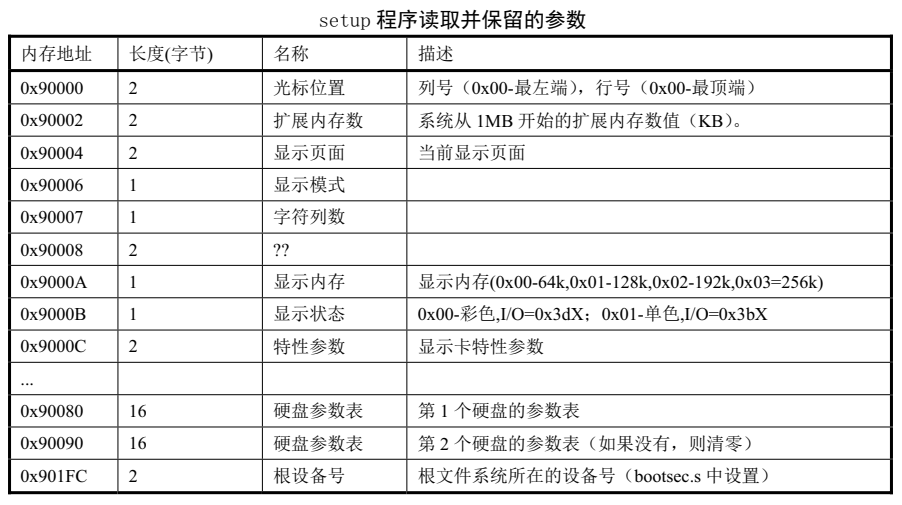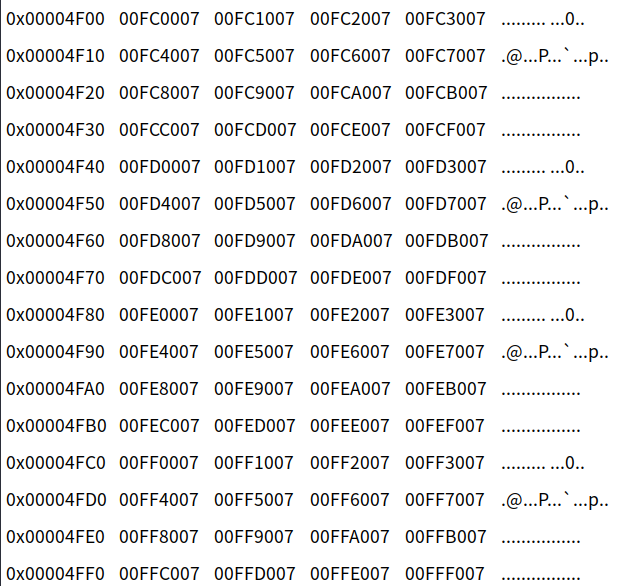

羽夏看Linux内核——引导启动(下) - 寂静的羽夏
source link: https://www.cnblogs.com/wingsummer/p/16581198.html
Go to the source link to view the article. You can view the picture content, updated content and better typesetting reading experience. If the link is broken, please click the button below to view the snapshot at that time.
此系列是本人一个字一个字码出来的,包括示例和实验截图。如有好的建议,欢迎反馈。码字不易,如果本篇文章有帮助你的,如有闲钱,可以打赏支持我的创作。如想转载,请把我的转载信息附在文章后面,并声明我的个人信息和本人博客地址即可,但必须事先通知我。
你如果是从中间插过来看的,请仔细阅读 羽夏看Linux系统内核——简述 ,方便学习本教程。
练习及参考
- 绘制执行进入保护模式的时候的内存布局状态。
🔒 点击查看答案 🔒
图是我自己画的,有的地方画的有点夸张,不是按照比例画的,仅供参考:

- 用表格的形式展示
setup.s程序在内存中保存的数据。
🔒 点击查看答案 🔒

.word 0x00eb,0x00eb的作用是啥?
🔒 点击查看答案 🔒
其实就是个 jmp 指令的二进制,由于每个指令执行都需要耗费几个机器时间,这里的作用就是延时。
- 介绍到最后的
jmpi 0,8代码最终跳到了哪个地址?为什么?
🔒 点击查看答案 🔒
最终跳到了 0 地址。由于目前 CPU 处于保护模式,8 现在是段选择子,含义是以 0环 权限使用索引为 1 的段描述符,是第二个,基址为 0 ,所以是 0 地址。
当前 CPU 状态
在正式开始之前我们得梳理一下当前CPU的状态,之后再继续讲解head.s这块代码。
当前,我们CPU已经开启了保护模式,但没有开启分页保护,也就是所谓的虚拟地址,只是有了段相关的权限检查。此时,我们的CPU地址具有32位的访问能力了。
清楚了目前的状态,我们就可以继续了。
head.s
head.s程序在被编译生成目标文件后会与内核其他程序一起被链接成system模块,位于system模块的最前面开始部分。system模块将被放置在磁盘上setup模块之后开始的扇区中,即从磁盘上第6个扇区开始放置。一般情况下Linux 0.11内核的system模块大约有120 KB左右,因此在磁盘上大约占240个扇区。
从此,CPU正式运行在保护模式了。汇编语法也变了,变成了比较麻烦的AT&T语法。对于AT&T汇编不熟悉的,可以参考我的 羽夏笔记—— AT&T 与 GCC ,别的教程也可。看明白后,回来继续。
在正式开始介绍之前,我们先把目前的GDT表的内容放上,IDT表目前是空的:
gdt:
.word 0,0,0,0 ! dummy
.word 0x07FF ! 8Mb - limit=2047 (2048*4096=8Mb)
.word 0x0000 ! base address=0
.word 0x9A00 ! code read/exec
.word 0x00C0 ! granularity=4096, 386
.word 0x07FF ! 8Mb - limit=2047 (2048*4096=8Mb)
.word 0x0000 ! base address=0
.word 0x9200 ! data read/write
.word 0x00C0 ! granularity=4096, 386
第一部分代码开始:
startup_32:
movl $0x10,%eax
mov %ax,%ds
mov %ax,%es
mov %ax,%fs
mov %ax,%gs
lss _stack_start,%esp
call setup_idt
call setup_gdt
可以看到mov指令来初始化段寄存器ds/es/fs/gs,指向可读可写但不能执行的数据段。然后加载堆栈段描述符,我们来看看_stack_start到底是啥:
long user_stack [ PAGE_SIZE>>2 ] ;
struct {
long * a;
short b;
} stack_start = { & user_stack [PAGE_SIZE>>2] , 0x10 };
诶?你是找不到滴。它在linuxsrc/kernel/sched.c文件当中。lss作用在这里最终的效果是把0x10作为段选择子加载到ss中,并将user_stack的地址放到esp中。
setup_idt和setup_gdt分别对应建立新的IDT表和GDT表,我们先看看setup_idt这个函数:
/*
* setup_idt
*
* sets up a idt with 256 entries pointing to
* ignore_int, interrupt gates. It then loads
* idt. Everything that wants to install itself
* in the idt-table may do so themselves. Interrupts
* are enabled elsewhere, when we can be relatively
* sure everything is ok. This routine will be over-
* written by the page tables.
*/
setup_idt:
lea ignore_int,%edx
movl $0x00080000,%eax
movw %dx,%ax /* selector = 0x0008 = cs */
movw $0x8E00,%dx /* interrupt gate - dpl=0, present */
lea _idt,%edi
mov $256,%ecx
rp_sidt:
movl %eax,(%edi)
movl %edx,4(%edi)
addl $8,%edi
dec %ecx
jne rp_sidt
lidt idt_descr
ret
ignore_int是一个函数,作用是打印Unknown interrupt这个字符串,然后结束。想看看的给你瞅一眼:
/* This is the default interrupt "handler" :-) */
int_msg:
.asciz "Unknown interrupt\n\r"
.align 2
ignore_int:
pushl %eax
pushl %ecx
pushl %edx
push %ds
push %es
push %fs
movl $0x10,%eax
mov %ax,%ds
mov %ax,%es
mov %ax,%fs
pushl $int_msg
call _printk
popl %eax
pop %fs
pop %es
pop %ds
popl %edx
popl %ecx
popl %eax
iret
_printk是一个函数,被定义在linuxsrc/kernel/printk.c的printk函数。_printk是printk函数编译成函数模块的表示名称。
前四行有效汇编就是构造一个中断门,用来作为默认的“中断处理程序”。后面就是用构造好的“中断处理程序”向存储中断表的_idt填充256次,最后加载构造完的新IDT表,虽然没啥真正的作用,但它有了真正的中断处理能力。
接下来看GDT的:
/*
* setup_gdt
*
* This routines sets up a new gdt and loads it.
* Only two entries are currently built, the same
* ones that were built in init.s. The routine
* is VERY complicated at two whole lines, so this
* rather long comment is certainly needed :-).
* This routine will beoverwritten by the page tables.
*/
setup_gdt:
lgdt gdt_descr
ret
这个函数更简单,这个是构造好了的。我们瞅一眼,顺便把IDT带上:
idt_descr:
.word 256*8-1 # idt contains 256 entries
.long _idt
.align 2
.word 0
gdt_descr:
.word 256*8-1 # so does gdt (not that that's any
.long _gdt # magic number, but it works for me :^)
.align 3
_idt: .fill 256,8,0 # idt is uninitialized
_gdt: .quad 0x0000000000000000 /* NULL descriptor */
.quad 0x00c09a0000000fff /* 16Mb */
.quad 0x00c0920000000fff /* 16Mb */
.quad 0x0000000000000000 /* TEMPORARY - don't use */
.fill 252,8,0 /* space for LDT's and TSS's etc */
我们继续:
movl $0x10,%eax # reload all the segment registers
mov %ax,%ds # after changing gdt. CS was already
mov %ax,%es # reloaded in 'setup_gdt'
mov %ax,%fs
mov %ax,%gs
lss _stack_start,%esp
xorl %eax,%eax
然后又来了一遍加载,每次更新GDT之后,由于段描述符的变化,我们必须重新加载一遍,保证与最新的保持一致。
1: incl %eax # check that A20 really IS enabled
movl %eax,0x000000 # loop forever if it isn't
cmpl %eax,0x100000
je 1b
这部分开始检查A20是否真正的开启了,防止出了差错,否则就一直循环。
/*
* NOTE! 486 should set bit 16, to check for write-protect in supervisor
* mode. Then it would be unnecessary with the "verify_area()"-calls.
* 486 users probably want to set the NE (#5) bit also, so as to use
* int 16 for math errors.
*/
movl %cr0,%eax # check math chip
andl $0x80000011,%eax # Save PG,PE,ET
/* "orl $0x10020,%eax" here for 486 might be good */
orl $2,%eax # set MP
movl %eax,%cr0
call check_x87
jmp after_page_tables
这段代码就是检查数字协处理器芯片是否存在。这个和硬件相关,这个不是我们的重点,简单了解即可。
完成无误后,我们跳转到after_page_tables:
after_page_tables:
pushl $0 # These are the parameters to main :-)
pushl $0
pushl $0
pushl $L6 # return address for main, if it decides to.
pushl $_main
jmp setup_paging
L6:
jmp L6 # main should never return here, but
# just in case, we know what happens.
到这里,我们开始压栈,这个是一个十分重要的点,我会留一个思考题在这里,这里先不讲。
压栈完毕后,然后跳转到setup_paging:
setup_paging:
movl $1024*5,%ecx /* 5 pages - pg_dir+4 page tables */
xorl %eax,%eax
xorl %edi,%edi /* pg_dir is at 0x000 */
cld;rep;stosl
movl $pg0+7,_pg_dir /* set present bit/user r/w */
movl $pg1+7,_pg_dir+4 /* --------- " " --------- */
movl $pg2+7,_pg_dir+8 /* --------- " " --------- */
movl $pg3+7,_pg_dir+12 /* --------- " " --------- */
movl $pg3+4092,%edi
movl $0xfff007,%eax /* 16Mb - 4096 + 7 (r/w user,p) */
std
1: stosl /* fill pages backwards - more efficient :-) */
subl $0x1000,%eax
jge 1b
xorl %eax,%eax /* pg_dir is at 0x0000 */
movl %eax,%cr3 /* cr3 - page directory start */
movl %cr0,%eax
orl $0x80000000,%eax
movl %eax,%cr0 /* set paging (PG) bit */
ret /* this also flushes prefetch-queue */
这些代码会让改Linux内核向现代操作系统更近了一步,开启分页保护。
在正式开始之前我们先回顾一下与分页相关的知识。

其中,有两个位我们必须清楚开启分页机制的位PG。
PG位是启用分页机制。在开启这个标志之前必须已经或者同时开启PE标志。PG = 0且PE = 0,处理器工作在实地址模式下。PG = 0且PE = 1,处理器工作在没有开启分页机制的保护模式下。PG = 1且PE = 0,在PE没有开启的情况下无法开启PG。PG = 1且PE = 1,处理器工作在开启了分页机制的保护模式下。
由于当前内存只有16 MB,所以它采用了10-10-12分页。setup_paging开始的代码将会在0地址开始设置页表,这会覆盖head.s的开头的代码。不过没关系,一切都在计算当中,并不会覆盖到当前要执行的代码。
看一下分页情况:
/*
* I put the kernel page tables right after the page directory,
* using 4 of them to span 16 Mb of physical memory. People with
* more than 16MB will have to expand this.
*/
.org 0x1000
pg0:
.org 0x2000
pg1:
.org 0x3000
pg2:
.org 0x4000
pg3:
为什么要按照0x1000都间隔进行分页呢?这个是由于CPU规定的,每个页表是0x1000字节的大小。这里一共分了4个页,对于16 MB内存足够了。
但是,为什么给_pg_dir赋值的要加个7呢?我们来看一下10-10-12分页:

到这里,你可能就意识到了:_pg_dir其实就是所谓的PDE,如果加了7,就是加上了几个最后三个属性。其实这几张页表都是内核专用的。
这几句汇编可能比较难懂一些:
movl $0xfff007,%eax /* 16Mb - 4096 + 7 (r/w user,p) */
std
1: stosl /* fill pages backwards - more efficient :-) */
subl $0x1000,%eax
jge 1b
我们现在的ecx是0,根据stos汇编的意思,也就是说把每一个页表填写上对应的数值,且执行一次。这么写的作用仅仅是为了更方便,更迅速。注意,它是从高地址向低地址填充页表的。
如果不理解,我们给一个最开始填充后的情况:

最后一块代码:
xorl %eax,%eax /* pg_dir is at 0x0000 */
movl %eax,%cr3 /* cr3 - page directory start */
movl %cr0,%eax
orl $0x80000000,%eax
movl %eax,%cr0 /* set paging (PG) bit */
ret /* this also flushes prefetch-queue */
由于访问物理内存需要CR3,它指向页目录表基址,所以给它赋值,之后开启分页保护开关,最后返回,所有的引导流程结束。
练习与思考
本节的答案将会在下一节进行讲解,务必把本节练习做完后看下一个讲解内容。不要偷懒,实验是学习本教程的捷径。
俗话说得好,光说不练假把式,如下是本节相关的练习。如果练习没做成功,就不要看下一节教程了。
- 复习本篇分析的代码流程,熟悉分页和中断门的构造。
- 在分页代码分析部分,你是怎么知道是
10-10-12分页,而不是2-9-9-12分页? - 最后的代码到底返回到了哪里?
- 绘制当前
system模块的内存分布。
羽夏看Linux内核——内核初始化
Recommend
About Joyk
Aggregate valuable and interesting links.
Joyk means Joy of geeK